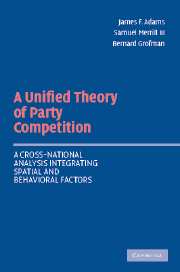 A Unified Theory of Party Competition
A Unified Theory of Party Competition Published online by Cambridge University Press: 04 December 2009
Introduction
In this chapter, we analyze candidate strategies for the U.S. presidential elections of 1980, 1984, 1988, 1996, and 2000 under the unified turnout model developed in Chapter 7. In exploring these elections we (1) focus on the divergence between the candidates' optimal strategies and how differing degrees of policy divergence between Democratic and Republican partisans affect the degree of divergence of optimal strategies, and (2) extend our analysis to encompass a fully unified turnout model in which voters discount the candidates' policy positions – a possibility that is empirically supported by Lacy and Paolino's (1998) analysis of voting in U.S. presidential elections.
Consistent with the theoretical analyses presented in Chapter 7, we find that for every presidential election we examine, the major party candidates had electoral incentives to present divergent policies when voters chose according to the unified turnout model. We also conclude that the degree of candidate divergence at equilibrium increases with the amount of divergence between the Democratic and Republican partisans. Finally, we find that policy discounting by voters would give the candidates additional incentives to diverge in the policy space, but not to diverge as much as the preferred positions of their partisan constituencies or the actual (perceived) positions of the candidates. We conclude that voters' turnout decisions are important for candidate strategies, an effect office-seeking candidates should take into account.
Hypotheses on Voting Behavior and Candidate Strategies under the Unified Turnout Model
We begin with two hypotheses about candidate strategies that we will test using data from the five American election studies. Each hypothesis applies to candidates' margin-maximizing policy positions for an empirically estimated turnout model.
To save this book to your Kindle, first ensure no-reply@cambridge.org is added to your Approved Personal Document E-mail List under your Personal Document Settings on the Manage Your Content and Devices page of your Amazon account. Then enter the ‘name’ part of your Kindle email address below. Find out more about saving to your Kindle.
Note you can select to save to either the @free.kindle.com or @kindle.com variations. ‘@free.kindle.com’ emails are free but can only be saved to your device when it is connected to wi-fi. ‘@kindle.com’ emails can be delivered even when you are not connected to wi-fi, but note that service fees apply.
Find out more about the Kindle Personal Document Service.
To save content items to your account, please confirm that you agree to abide by our usage policies. If this is the first time you use this feature, you will be asked to authorise Cambridge Core to connect with your account. Find out more about saving content to Dropbox.
To save content items to your account, please confirm that you agree to abide by our usage policies. If this is the first time you use this feature, you will be asked to authorise Cambridge Core to connect with your account. Find out more about saving content to Google Drive.